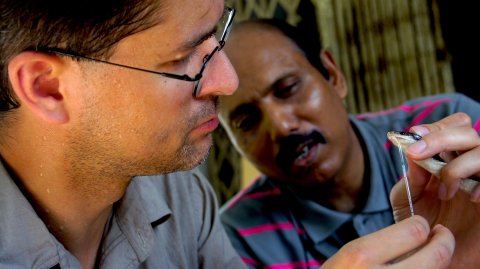Snakebite Research: Past, Present, and Future

This International Snakebite Awareness Day, Dr Frank Tianyi, co-Guest Editor of our forthcoming Snakebite Special Issue and Tamar Ghosh, RSTMH’s Chief Executive, look at what has been achieved so far in snakebite elimination, as well as next steps.
Snakebite, despite being very common in a number of parts of the world, has been historically under-researched and had little to no investment. The current treatments for snakebite were developed over 100 years ago, and there are few diagnostic options for patients with a snakebite. Consequently, the burden of snakebite envenoming remains high, particularly in low- and middle-income countries. Today, on international snakebite awareness day, we reflect on our work of improving snakebite research globally.
Past
At the Royal Society of Tropical Medicine and Hygiene (RSTMH), we have been publishing snakebite research since 1947, with our first publication by Grasset and Goldstein. This early work laid the foundation for understanding the complexities of snakebite venom and the urgent need for effective treatments and diagnostics. We have since consistently published snakebite research and advocated for more attention and investment. We collaborated with partners around the world including MSF, Wellcome, GSI and HAI to launch International Snakebite Awareness Day in 2018, and in 2019, we published a collection of stories from front-line actors and community groups leading the fight against snakebite. In 2021 we launched a three-year partnership with the Wellcome Trust, to plant seeds for innovative research in snakebite treatment and prevention through our Early Career Grants Programme (formally called the Small Grants Programme). The partnership with Wellcome directly supported more than 40 awardees from more than 10 countries delivering a diverse range of snakebite research projects. Through the wider Programme tens more snakebite researchers were able to receive their very first research award. Through ISBAD, regular communications about snakebite, plus wider activities from our partners we saw the number of applications for snakebite projects grow within our Programme from less than 15 in 2019 to over a hundred in 2024. These initiatives have supported numerous early-career researchers and has led to significant advancements in the field.
Present
This year, we launched our first-ever Special Issue on snakebite, highlighting the latest research and developments in the field. This Special Issue sought to bring together researchers from around the world to share their findings and collaborate on solutions to reduce the burden of snakebite envenoming. We have received a record number of submissions from countries across Africa, Asia, and South America countries, which reflects the geographies with the highest burden of snakebite globally. Of the submissions we have seen many from our network of Early Career Grant Awardees, enabling us to further support talented early career researchers, initially with funding, and now with a platform to publish their work.
Future
As we look forward to the next few years, factors such as increasing conflicts and climate change are likely to exacerbate human-snake confrontations, leading to a higher incidence of snakebites globally. We at RSTMH are excited to promote and support early-career researchers living and working in countries with the highest burden of snakebite to find creative and innovative solutions to reduce the burden of snakebite. Expanding our pipelines beyond the Early Career Grants Programme and creating a space for talented individuals to share their research seems to be a good first step. The support of our funding partners has been instrumental in getting us here, and we hope that our funders will continue to support the work we do, and plan to do, in snakebite research.
We hope that this continued effort in supporting research will lead to new and innovative solutions and a sustainable reduction in the burden of snakebite. By fostering collaboration and innovation, we hope to make significant strides for this neglected tropical disease.
Please keep in touch with us through our newsletter for information of when our first Snake Special Issue will be published later on this year.